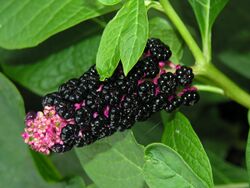Biology:Phytolaccaceae
From HandWiki
Short description: Family of flowering plants
| Phytolaccaceae | |
|---|---|

| |
| Phytolacca acinosa | |
| Scientific classification | |
| Kingdom: | Plantae |
| Clade: | Tracheophytes |
| Clade: | Angiosperms |
| Clade: | Eudicots |
| Order: | Caryophyllales |
| Family: | Phytolaccaceae R.Br.[1][2] |
| Genera | |
| |
| Synonyms | |
|
Agdestidaceae Nakai | |
Phytolaccaceae is a family of flowering plants. Though almost universally recognized by taxonomists, its circumscription has varied. It is also known as the Pokeweed family.
The APG II system, of 2003 (unchanged from the APG system, of 1998), also recognizes this family and assigns it to the order Caryophyllales in the clade core eudicots. The family comprises five genera, totalling 33 known species.[3] It is divided into the subfamilies Agdestioideae and Phytolaccoideae, with the former Rivinioideae in the Takhtajan system,[4] now placed in its own family Petiveriaceae
Genera and species
The Phytolaccaceae includes the following genera:
- Agdestis Moc. & Sessé ex DC. — 1 species
- Anisomeria D.Don — 3 species
- Ercilla A.Juss. — 2 species
- Nowickea J.Martínez & J.A.McDonald — 2 species
- Phytolacca L. — ca 25 species
Former genera
The following genera were previously included in the Phytolaccaceae:[5]
- Achatocarpus Triana → Achatocarpaceae
- Barbeuia Thouars → Barbeuiaceae
- Gallesia Casar. → Petiveriaceae
- Gisekia L. → Gisekiaceae
- Hilleria Vell. → Petiveriaceae
- Gyrostemon Desf. → Gyrostemonaceae
- Ledenbergia Klotzsch ex Moq. → Petiveriaceae
- Lophiocarpus Turcz. → Lophiocarpaceae
- Microtea Sw. → Microteaceae
- Monococcus F.Muell. → Petiveriaceae
- Petiveria L. → Petiveriaceae
- Phaulothamnus A.Gray → Achatocarpaceae
- Rivina L. → Petiveriaceae
- Schindleria H.Walter → Petiveriaceae
- Seguieria Loefl. → Petiveriaceae
- Stegnosperma Benth. → Stegnospermataceae
- Trichostigma A.Rich. → Petiveriaceae
References
- ↑ "Family: Phytolaccaceae R. Br., nom. cons.". Germplasm Resources Information Network. United States Department of Agriculture. 2003-01-17. http://www.ars-grin.gov/cgi-bin/npgs/html/family.pl?876.
- ↑ Angiosperm Phylogeny Group (2009). "An update of the Angiosperm Phylogeny Group classification for the orders and families of flowering plants: APG III". Botanical Journal of the Linnean Society 161 (2): 105–121. doi:10.1111/j.1095-8339.2009.00996.x. http://onlinelibrary.wiley.com/doi/10.1046/j.1095-8339.2003.t01-1-00158.x/pdf.
- ↑ Christenhusz, M. J. M.; Byng, J. W. (2016). "The number of known plants species in the world and its annual increase". Phytotaxa 261 (3): 201–217. doi:10.11646/phytotaxa.261.3.1. http://biotaxa.org/Phytotaxa/article/download/phytotaxa.261.3.1/20598.
- ↑ Takhtajan, Armen (2009). Flowering Plants (2 ed.). Springer. p. 136. ISBN 978-1-4020-9608-2. https://books.google.com/books?id=oumyfO-NHuUC.
- ↑ "GRIN genera sometimes placed in Phytolaccaceae". Germplasm Resources Information Network. United States Department of Agriculture. http://www.ars-grin.gov/cgi-bin/npgs/html/gnothlist.pl?876.
External links
- Phytolaccaceae in L. Watson and M.J. Dallwitz (1992 onwards). The families of flowering plants: descriptions, illustrations, identification, information retrieval. Version: 30 May 2006. http://delta-intkey.com
- Phytolaccaeae in the Flora of North America
- Phytolaccaeae in the Flora of China
- NCBI Taxonomy Browser
- Pictures of representative species
Wikidata ☰ Q156981 entry
 |

